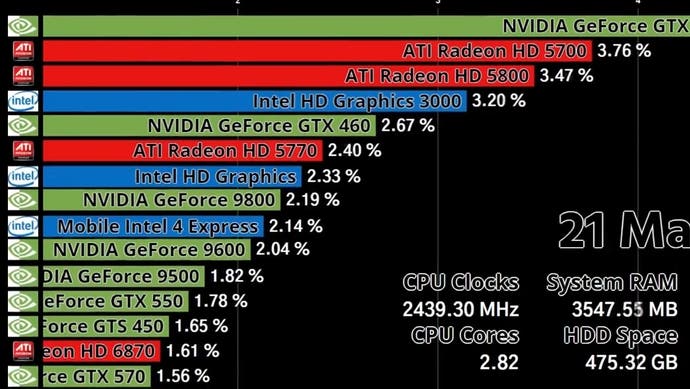New video shows the rise and fall of AMD, Intel and Nvidia graphics cards
15 years of GPU market share data compressed into a three minute vid.
YouTube channel TheRankings has made an incredible video showing the 15 most popular graphics cards over time, based on data from the Steam Hardware Survey. The animation packs fifteen years of history - from 2004 to 2019 - into a brief three minute video that's well worth watching - whether you're a long-time PC gamer looking for a hit of nostalgia or a relative newcomer seeking a bit of perspective.
When the video starts in April 2004, there are already some big names on the list, like the legendary Nvidia TNT2 and the ATI Radeon 9600. However, it's the GeForce4 and GeForce4 MX that are the out-and-out leaders, making up 28.5 per cent of all Steam users at the time. It's fascinating to see how ATI and Nvidia are close rivals early on, with the GeForce 6600 and 7600 proving popular but AMD's counterparts holding strong too. Things get turned on their head in late 2007 though, as the GeForce 8800 gives Nvidia a massive advantage, shooting up to 13 per cent of all graphics cards on Steam and staying in the number one slot until early 2010.
The next era is again close, with AMD's HD 4000-series and 5000-series holding firm in the early 2010s. AMD take first place in March 2012 with the Radeon HD 5770, but soon lose ground to the runaway success that is the GTX 560; AMD never holds the top slot again. Intel integrated graphics chips were added to the Steam Hardware survey in 2012 and immediately become a force to be reckoned with, speaking to the vast amount of Steam users playing on laptops - the HD 3000 and HD 4000 take the top two slots from June 2013 to July 2015.
From 2014 to 2015, AMD struggles to stay in the top fifteen, finally falling out in September 2016. From here on, it's more or less a two-player ballgame, with Nvidia taking almost all of the top 15 slots and Intel's integrated graphics making up the remainder. Nvidia's GTX 9-series and 10-series cards are just too strong, although a special mention has to be made for the cut-price GTX 750 Ti as well. The final success story is the GTX 1060; despite having less raw power than the similarly-priced RX 580, the Nvidia card has become by far the most popular graphics card on the market, totalling 15 per cent of the Steam userbase to this day.

So what can we learn from the video as a whole? Well, Nvidia is clearly the king of gaming graphics cards these days and its stranglehold over the market has only increased over the past few years, despite some strong offerings from AMD in recent times, like the Radeon RX 580 and Vega 56. Nvidia also dominates the modern laptop market too, giving Team Green a substantial advantage. The video also confirms that Nvidia's mid-range cards, which traditionally end in XX60, are by far its best sellers historically, and we've just seen the release of the new GTX 1660 and 1660 Ti. However, there have been exceptions too from higher-grade cards that offered outstanding bang for the buck in their day - like the 8800GT/8800GTX in 2006 and GTX 970 in 2014.
As well as the GPU rankings, you can also see some average specs in the bottom right. Even in early 2019, we're still a little way off from averaging 1920x1080 in the resolution stakes, with more people using lower resolutions (eg 1680x1050, 1366x768) than use higher resolutions (eg 2560x1440 or 3840x2160). Likewise, you can see that 4GB of video memory and 8GB of system memory have become standard. In terms of processors, a statistically average CPU would be a quad-core model running at 2.8GHz - like an AMD Phenom II X4, to pick one at random. However, these averages don't tell the whole story, and it would be fascinating to see further videos for other Steam Hardware Survey data points.
It'll also be interesting to see how this chart looks in a few years' time. With AMD's long-rumoured Navi graphics cards on the horizon and Intel looking to make a move into creating discrete desktop GPUs too, Nvidia's domination of gaming graphics hardware could face some stiff competition and the possibility always exists for market conditions to shift substantially. After all, this has happened before and may well happen again.


